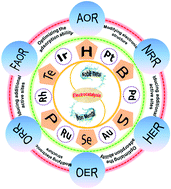Nonmetal-doping of noble metal-based catalysts for electrocatalysis
Abstract
In response to the shortage of fossil fuels, efficient electrochemical energy conversion devices are attracting increasing attention, while the limited electrochemical performance and high cost of noble metal-based electrode materials remain a daunting challenge. The electrocatalytic performance of electrode materials is closely bound with their intrinsic electronic/ionic states and crystal structures. Apart from the nanoscale design and conductive composite strategies, heteroatom doping, particularly for nonmetal doping (e.g., hydrogen, boron, sulfur, selenium, phosphorus, and tellurium), is also another effective strategy to greatly promote the intrinsic activity of the electrode materials by tuning their atomic structures. From the perspective of electrocatalytic reactions, the effective atomic structure regulation could induce additional active sites, create rich defects, and optimize the adsorption capability, thereby contributing to the promotion of the electrocatalytic performance of noble metal-based electrocatalysts. Encouraged by the great progress achieved in this field, we have reviewed recent advancements in nonmetal doping for electrocatalytic energy conversion. Specifically, the doping effect on the atomic structure and intrinsic electronic/ionic state is also systematically illustrated and the relationship with the electrocatalytic performance is also investigated. It is believed that this review will provide guidance for the development of more efficient electrocatalysts.

- This article is part of the themed collection: Recent Review Articles


 Please wait while we load your content...
Please wait while we load your content...